Gynecomastia Type 5- Chest Angle Greater than 90° Significant Sag
Definition
Chest angle is greater than 90 degrees. Breast tissue sags below chest fold. Signficant chest sag.
- Overview of Gynecomastia
- Causes of Gynecomastia
- Ideal male chest
- Joseph T Cruise, MD's Gynecomastia Philosophy
- 7 Types of Gynecomastia
- 1-Puffy nipple. Breast tissue outside of areola
- 2-Chest angle less than 45 °
- 3-Chest angle 45-60° Mild breast sag
- 4-Chest angle 60-90° Moderate breast sag
- 5-Chest angle greater than 90° Significant sag
- 6-Top of areola is above chest fold. Severe sag
- 7-Top of areola is below chest fold. Extreme sag
- Are You a Good Candidate?
- Benefits of Male Breast Reduction
- Components of Gynecomastia
- Classic Gynecomastia
- Puffy Nipples
- Fatty Gyecomastia
- Saggy Gynecomastia
- Breast Roll
- Prior to Male Breast Reduction
- Male Breast Reduction Anesthesia
- After the Male Breast Reduction
- Recovery from Male Breast Reduction
- Possible Complications
- Gynecomastia Cost and Financing
- Gynecomastia Words to Know
- Gynecomastia Before and After Pictures
Physical Exam
Type 5 gynecomastia is defined as breast tissue that drops below the chest fold as shown in the two images below. has sagging breast tissue below the chest fold and the bottom of the areola is located above the chest fold. The main surgical difference of a Type 5 from a Type 4 is that a donut lift will not reliably tighten the skin enough to produce an acceptable appearance.
Gynecomastia Type 5
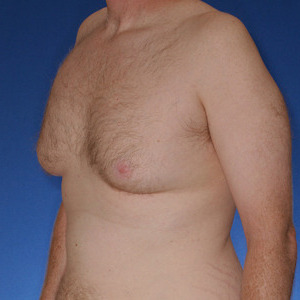
chest fold.
If a donut lift were performed on a type 6 one of two things would happen. One, the donut lift would be so big that it would leave significant rippling and a poor scar or, two, the chest would sag.
The image below outlines the 7 types of gynecomastia. Types 1 is Puffy Nipple. Types 2-5 are determined by the chest angle. Types 6 and 7 are determined by the position of the nipple in relation to the chest fold.
Gynecomastia Types
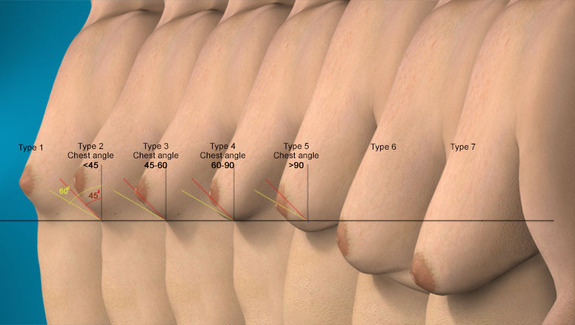
The purpose of categorizing gynecomastia is to determine what type of surgery is necessary to correct a given problem. Joseph T Cruise, MD has developed this classification system based on the extensive work he has done with gynecomastia patients. Other surgeons may use other methods.
Here is how the type of surgery changes depending on the gynecomastia type.
Type 1 - Incision at lower margin of areola
Type 2 - Incision at lower margin of areola
Type 3 - Incision at lower margin of areola or donut lift
Type 4 - Donut lift or anchor lift
Type 5 - Anchor lift
Type 6 - Anchor lift or free nipple graft
Type 7 - Free nipple graft
Here is an enlarged view to show the differences between Types 2-5. The reason why these are grouped together is because the differences are relatively close but they are enough to change the type of surgery necessary to obtain a good result.
Skin laxity differences between types 2-5
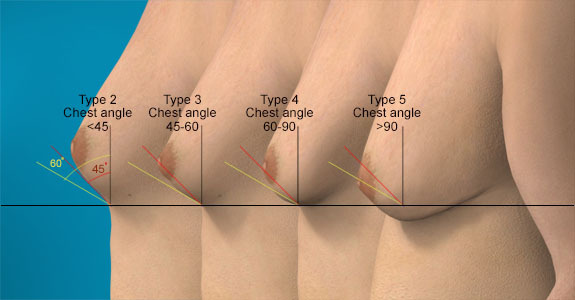
Diagnosing a Type 2,3,4 and 5 gynecomastia. The major difference between the different types is not so much the volume, but rather the skin excess. As you go up, the amount of skin excess increases. This increase in skin excess changes the procedure necessary to correct it. With increasing skin excess, the chest will sag more. This will result in the Chest Fold Angle (CFA) getting smaller and smaller as shown above. Keep in mind, when the breast volume is removed the chest will deflate causing significantly more chest sag. This will further increase the need for skin removal. Failure to address the skin laxity may make the sagginess worse. Fortunately, for type 2 gynecomastia, the chest will likely "snap back" without any skin removal.
- Type 2 <45 degrees
- Type 3 45-60 degrees
- Type 4 60-90 degrees
- Type 5 >90 degrees
Surgical implications
- Liposuction
May or may not be useful to remove breast tissue depending on whether or not it is fatty or glandular. If patient is heavy, it may be used to flatten breast roll or decrease fatty deposits at chest margin. - Surgical removal of breast tissue
Surgical removal of breast tissue is often method of choice to ensure that all necessary breast tissue is removed.
Difference between a donut lift and anchor lift in a Type 5

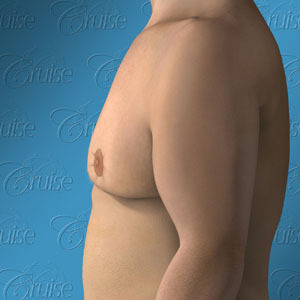
Breast tissue removal with donut liftNotice the contour irregularity at the bottom of the
chest and the rippling around the areola.
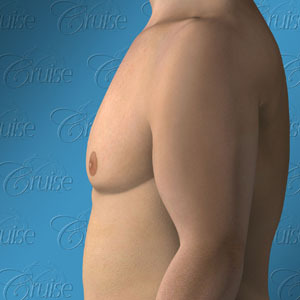
Breast tissue removal with anchor lift Notice how the skin envelop is much tighter than with the donut lift.
Preferred incision for Type 5
Type 1 - Incision at lower margin of areola
Type 2 - Incision at lower margin of areola
Type 3 - Incision at lower margin of areola or donut lift
Type 4 - Donut lift or anchor lift
Type 5 - Anchor lift
Type 6 - Anchor lift or free nipple graft
Type 7 - Free nipple graft
Incisions for Type 5 gynecomastia
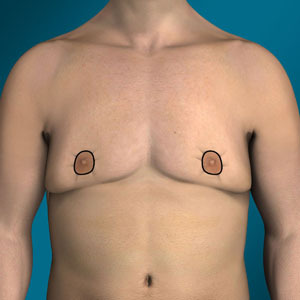
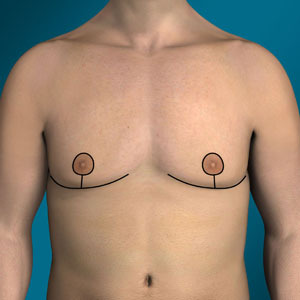
Type 5 gynecomastia is treated with an anchor lift. Patients with Type 5 have too much excess skin to be treated effectively with a donut lift. If a donut lift were performed on a Type 5 there would be significant rippling as well as persistent saggy breast tissue.


